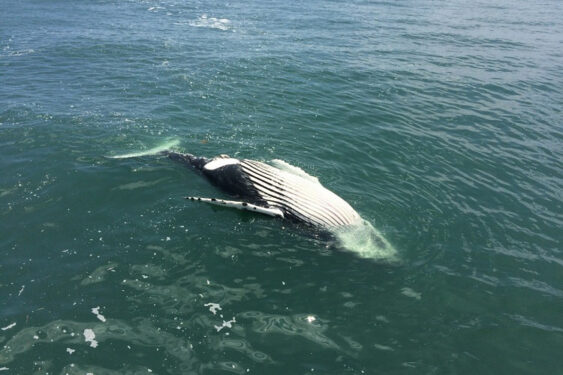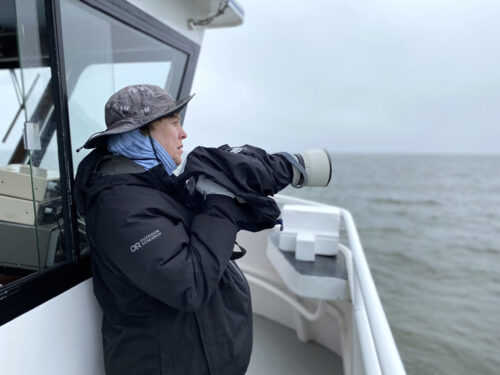
SHEEPSHEAD BAY — Meet “Jerry,” a frequent visitor to the Big Apple where he consumes massive amounts of seafood.
Jerry is one of hundreds of humpback whales known to appear off the coasts of New York and New Jersey. Whale watchers identify him by the distinctive markings on the underside of his tail fins.
His thrilling off-shore visits — in which he lunges from the sea and returns with huge splashes — made him the subject of a childrens’ book, “Big Whale, Big City.” Marine mammal enthusiasts haven’t spotted him yet this year, which is not unusual, they say.
Meanwhile, scientists and advocates are investigating recent fatal strandings of humpback whales like Jerry on New York and New Jersey beaches. Six total turned up in 2022, followed by a dozen in the first half of 2023.
Researchers suspect some of these whales collided with container ships destined for the Port of New York and New Jersey, said Paul Sieswerda, a whale advocate. He is the founder and executive director of the non-profit group, Gotham Whale, based on Staten Island, and the author of “Big Whale, Big City.”
“The whales,” Sieswerda said, “are playing in traffic.”
Baitfish Buffet
Recent whale deaths seem to correlate with an exploding population of a major food source — Atlantic menhaden, also called “bunker fish.”
Celia Ackerman, a naturalist for Gotham Whale, called the oily, boney menhaden a “keystone” species.
“It supports a wide diversity of marine life,” she said, “such as whales and dolphins, but also striped bass, bluefish, sharks, and seabirds.”
The menhaden’s proliferation, Ackerman said, results from improved water quality. She credited the Clean Water Act, rewritten in 1977, which curbed litter, trash, and chemicals in oceans. Better fishery management also spurred baitfish growth, she said.
Whales subsequently identified a bunker buffet near the Verrazano-Narrows Bridge.
“All that feeding activity is taking place just outside of that,” Sieswerda added. “That is where the whales are. But it’s also where the shipping lanes are.”
Blunt-Force Trauma
Sieswerda explained that the port — the busiest in the U.S. as of 2022 — is seeing a dramatic boost in cargo traffic as the nation’s “supply chain” of goods and materials staggers back from COVID-related disruptions.
But whales destined for the menhaden fisheries may be colliding with cargo ships first, Sieswerda said.
“The whales that have been washing up may have been hit offshore and then float in and end up on the beach,” Sieswerda said.
According to NOAA, necroscopies on beached whales suggest some of them died of “blunt-force trauma.”

Save the Whales
Founded in 2011, Gotham Whale maintains a database of marine mammal sightings called “The NYC Humpback Whale Catalog.”
The group has a partnership with the American Princess, a whale-watching boat that launches from Sheepshead Bay.
During these excursions the volunteers record data to track the whales, their locations, and behaviors. They also teach passengers about the humpback and other marine mammals, like dolphins.
Whale-watching season generally lasts from April to November.
Passengers launching from New York can usually see humpbacks, although other species can appear, like the minke, fin, blue, and sperm whales; also bottlenose dolphins, killer whales and harbor seals.
“The whales that we see here overwinter in the Caribbean,” Ackerman said. “Some we’ve only seen once and we don’t see them again.
“But about 30% of our catalog are ‘returning whales.’ They are remembering our waters as a place where they can come and reliably find food.”
But they also risk colliding with a ship, Sieswerda said.
“I don’t have a good answer for mitigating,” he said. “There are some restrictions on ship speeds, but that’s primarily for the critically endangered North Atlantic right whale. Mostly we’re seeing humpback whales.”
Stewardship, Not Exploitation
Pope Francis does not mention whales in his 2015 encyclical, “Laudato Si’: On Care of Our Common Home.” Still, he makes the case for stewardship of all species in Creation.
“It is not enough,” he wrote, “to think of different species merely as potential ‘resources’ to be exploited, while overlooking the fact that they have value in themselves. Because of us, thousands of species will no longer give glory to God by their very existence, nor convey their message to us. We have no such right.” [33]
He continued, “All of this helps us to see that every intervention in nature can have consequences which are not immediately evident, and that certain ways of exploiting resources prove costly in terms of degradation which ultimately reaches the ocean bed itself.” [40]
Meghan Clark, a professor of theology at St. John’s University, agreed with Pope Francis. She specializes in moral theology and Catholic social thought, and writes for several magazines, including U.S. Catholic and America.
She also lives in the Rockaways, a prime spot to view marine life.
“In ‘Laudato Si’,’ Pope Francis invites us to remember that all creation is loved by God,” Clark said. “The oceans are not ours to use but ours to protect and share.
“As a resident of the Rockaways, I rejoice when I see whales back in our waters but we have a responsibility to be good neighbors, protecting the ocean life.”
Vessel Initiative
Officials from the government and the shipping industry are responding to whale deaths.
For example, the Port Authority for New York and New Jersey has implemented a “Clean Vessel Incentive.”
Also called CVI, this program has a “Vessel Speed Reduction” component, rewarding ships that cut speeds while approaching the harbor.
This will reduce air pollutants, CO2 emissions, “and the risk of fatal strikes on whales,” according to the Port Authority’s website.
Sieswerda noted, however, that Gotham Whale and the American Princess also play a role in whale safety.
“We can provide a good view of where the whales are,” he said. “And also when they are likely to be in the area. It’s almost a real-time report of whales, relative to these shipping lanes into the port.”
In turn, cargo ship crews often radio the American Princess to report whale sightings as the vessels pass each other.
Iconic Whale
The volunteers identify Jerry and podmates by the markings on their tail fins, Ackerman said.
“That pattern is unique, like a human fingerprint,” explained Ackerman, moments before the launching of a whale-watching excursion from Sheepshead Bay.
“No two whales have that same pattern,” she said. “So if we find a whale today, and this whale dives down, that’s what I’m going to try to photograph — the underside of the tail. If it’s not diving down, I will try to photograph the dorsal fin.”
This is how the volunteers became acquainted with Jerry.
Sieswerda, who wrote “Big Whale, Big City,” said Jerry became an “iconic whale” when the group’s photographer, Artie Raslich, captured an image of him rising from the waves.
The New York City skyline, including the Empire State Building, was in the background. It happened on Aug. 1, the birthday of Jerry Garcia, famed frontman for the iconic Grateful Dead rock band.
Raslich, being a “Dead Head,” called the whale “Jerry,” and the name stuck, Sieswerda said. Since 2011, Gotham Whale has spotted Jerry “every year except 2016,” Ackerman said.
“We have not seen Jerry this year,” she said. “But we still have a few months to go. We’ll definitely keep an eye out for him.”
